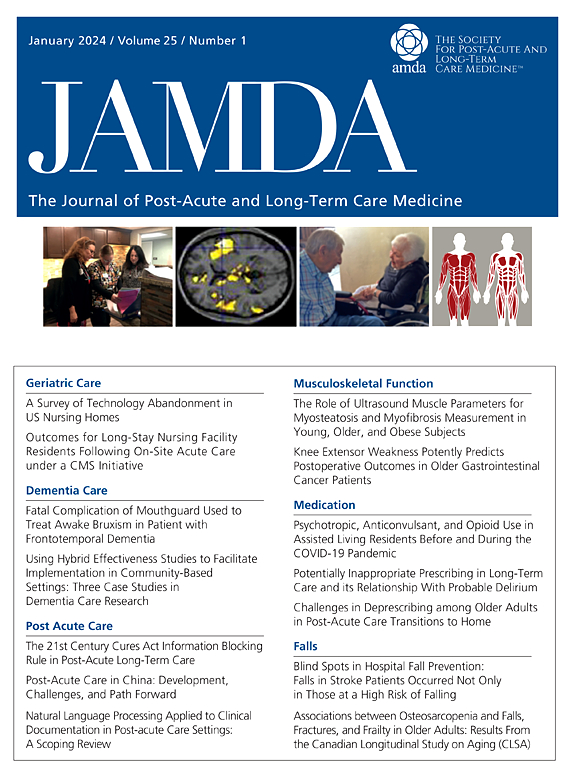Antipsychotic Use in Older Adults with Dementia: Community and Nursing Facility Trends in Texas, 2015-2020
IF 4.2
2区 医学
Q2 GERIATRICS & GERONTOLOGY
Journal of the American Medical Directors Association
Pub Date : 2025-02-06
DOI:10.1016/j.jamda.2024.105463
引用次数: 0
Abstract
Objectives
To assess recent trends in antipsychotic use among older adults with Alzheimer's disease and related dementias (ADRDs) according to their residential status and determine the factors associated with the use of antipsychotics.
Design
Population-based, cross-sectional study using Texas Medicare Fee-for-Service data.
Setting and Participants
Individuals aged ≥ 65 years with ADRDs who had at least 3 months of Medicare Part A and B, and Part D for prescription drug coverage, in any year between 2015 and 2020.
Methods
Temporal trends for antipsychotic use were reported by calendar year, and the associations between antipsychotic use and potential predictors were assessed overall and by residential status.
Results
Among an annual average of 161,848 older adults with ADRDs (median age, 82 years; 64.8% female), overall antipsychotic use decreased by 25.8%, from 14.5% in 2015 to 10.8% in 2020. The decline was primarily observed among those with any nursing facility (NF) residence, where use dropped from 22.1% to 12.4%, whereas community-dwelling individuals maintained a steady rate of approximately 10%. Factors associated with increased antipsychotic use included male sex, Black and Hispanic individuals, dual eligibility, Alzheimer's disease (non-Alzheimer's disease), emergency department visits, hospitalization, depression, and anxiety disorders. However, these associations varied across residential statuses. Older age was more strongly associated with decreased antipsychotic use among those with NF residence than those in the community. Compared with white individuals, Black individuals were more likely to receive antipsychotics in the community, whereas Hispanic and Asian individuals were more likely to receive antipsychotics among those with NF residence.
Conclusions and Implications
Although antipsychotic use substantially decreased among those with NF residence, it remained steady among community-dwelling individuals. Given that two-thirds of individuals with dementia reside in the community, more attention is needed to understand antipsychotic use in this population.
老年痴呆患者抗精神病药物的使用:2015-2020年德克萨斯州社区和护理机构趋势
目的:根据居住状况评估老年阿尔茨海默病及相关痴呆(ADRDs)患者抗精神病药物使用的最新趋势,并确定与抗精神病药物使用相关的因素。设计:基于人群的横断面研究,使用德克萨斯州医疗保险服务收费数据。环境和参与者:在2015年至2020年之间的任何一年,年龄≥65岁且患有不良反应的个体,至少有3个月的医疗保险A、B部分和D部分处方药覆盖。方法:按日历年报告抗精神病药物使用的时间趋势,并根据总体和居住状况评估抗精神病药物使用与潜在预测因素之间的关系。结果:在平均每年161,848例adds老年人中(中位年龄82岁;总体抗精神病药物使用下降25.8%,从2015年的14.5%降至2020年的10.8%。这种下降主要发生在任何护理机构(NF)居住的人群中,其使用率从22.1%下降到12.4%,而社区居住的个人则保持在10%左右的稳定比率。与抗精神病药物使用增加相关的因素包括男性、黑人和西班牙裔个体、双重资格、阿尔茨海默病、急诊科就诊、住院、抑郁和焦虑症。然而,这些关联因居住状态而异。与居住在社区的患者相比,居住在NF社区的患者年龄与抗精神病药物使用减少的相关性更强。与白人个体相比,黑人个体更可能在社区接受抗精神病药物治疗,而西班牙裔和亚裔个体更可能在NF居住地接受抗精神病药物治疗。结论和意义:虽然抗精神病药物的使用在NF患者中显著减少,但在社区居民中保持稳定。鉴于三分之二的痴呆症患者居住在社区,需要更多的关注来了解这一人群的抗精神病药物使用情况。
本文章由计算机程序翻译,如有差异,请以英文原文为准。
求助全文
约1分钟内获得全文
求助全文
来源期刊
CiteScore
11.10
自引率
6.60%
发文量
472
审稿时长
44 days
期刊介绍:
JAMDA, the official journal of AMDA - The Society for Post-Acute and Long-Term Care Medicine, is a leading peer-reviewed publication that offers practical information and research geared towards healthcare professionals in the post-acute and long-term care fields. It is also a valuable resource for policy-makers, organizational leaders, educators, and advocates.
The journal provides essential information for various healthcare professionals such as medical directors, attending physicians, nurses, consultant pharmacists, geriatric psychiatrists, nurse practitioners, physician assistants, physical and occupational therapists, social workers, and others involved in providing, overseeing, and promoting quality

 求助内容:
求助内容: 应助结果提醒方式:
应助结果提醒方式:


